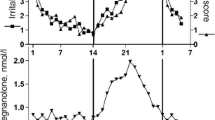Summary
Premenstrual dysphoric disorder (PMDD) is characterized by depression, anxiety and other affective symptoms which recur in the luteal phase of the menstrual cycle. Evidence from animal models of depression and anxiety indicate the importance of neuroactive steroid hormones and the GABAA receptor in the etiology and potential treatment of mood disorders. These data are reviewed in the light of human clinical studies and specific animal models of PMDD.
Similar content being viewed by others
Author information
Authors and Affiliations
Additional information
Received April 22, 2002; accepted August 20, 2002 Published online October 30, 2002
Correspondence: Inger Sundström, M.D., Ph.D., Department of Clinical Science, Obstetrics and Gynecology, University Hospital of Umeå, S-901 85 Umeå, Sweden; e-mail: inger.sundstrom@obgyn.umu.se
Rights and permissions
About this article
Cite this article
Sundström Poromaa, I., Smith, S. & Gulinello, M. GABA receptors, progesterone and premenstrual dysphoric disorder. Arch Womens Ment Health 6, 23–41 (2003). https://doi.org/10.1007/s00737-002-0147-1
Issue Date:
DOI: https://doi.org/10.1007/s00737-002-0147-1




